Smallmouth bass prefer sand, rocks and wood in conjunction to major depth contour. However, they can also be found using weedlines at certain times of the year. On natural lakes and reservoirs, anglers can expect to find big smallmouths in the underfished habitat of weeds.
The late summer/early fall period is a perplexing time for smallmouth bass anglers. Predictably on most days, fish may be located on the same hard bottom deep water habitats they’ve been using all summer long. Even though finding these obvious late summer locations can be easy with electronics and mapping systems, catching the fish is another story. Other days they’re nowhere to be found on rocks, or in deep water for the matter, and are eluding the very best anglers. The fish have definitely gone elsewhere.
If smallmouths aren’t using rocks, where can they be?
On the large natural lakes, flowages, and river systems encompassing weed habitats, it is common for smallmouth bass to dwell amongst the jungle of weeds and their corresponding weedlines. Smallmouths in weeds happen far more often than anyone thinks.
Largemouth bass anglers understand the dynamics of fishing weeds. However, smallmouth anglers in particular aren’t able to realize the connection as easily or efficiently.
The natural lakes I frequently fish up north are notoriously difficult for the best anglers come late summer. The majority of these lakes feature a good number of rock and sand shorelines with deeper offshore structures and large expanses of deep open water. In addition, several of them contain schools of pelagic baitfish species which in turn attract smallmouths. In late summer, these lakes are difficult to fish because few fish are ever found shallow, most food sources are scattered, and fish tend to roam. Along with these biological factors, fishing these lakes in late summer becomes laughable when faced with high pressure weather conditions and lack of wind. At this point we might as well put the boat away and wait until the first cold snap of autumn, right?
Given these circumstances, anglers have no reason to fret or experience continued struggles in locating smallmouth bass. Fishing these types of difficult lakes becomes substantially easier if weedlines are present. I’ve observed that if the lake’s largemouth bass use them, smallmouths will too.
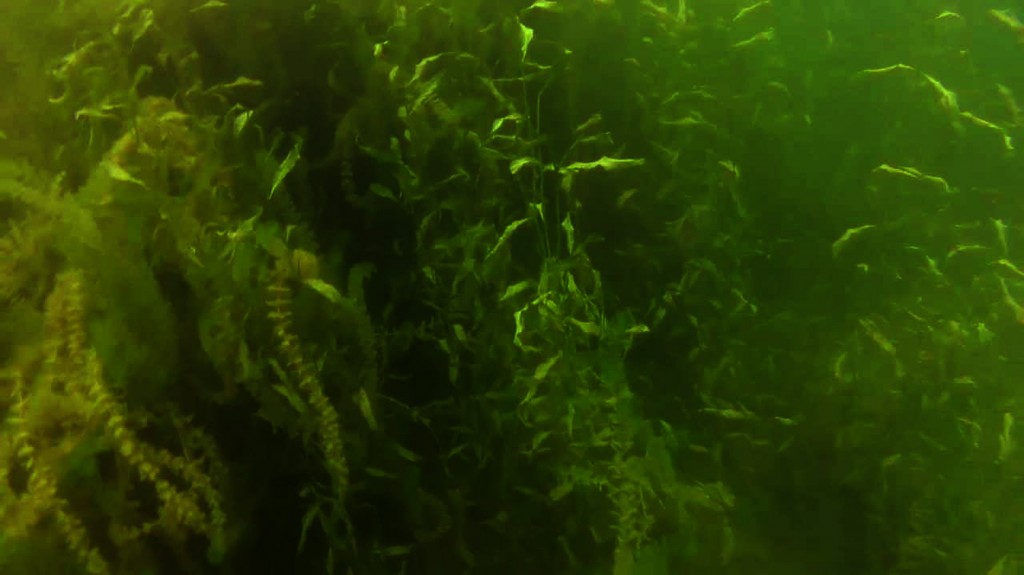
Why weeds and which fish best?
There are two main reasons for smallmouth bass to be in the weeds and patrol their weedlines. First, the oxygen content and sanctuary of weeds will attract crayfish and schools of baitfish including hordes of young of year perch and bluegills. This predator-prey relationship predominantly occurs in lush green weeds that are vibrant with life. Because of this factor, weeds offer smallmouths an easy ambush point, and access to food. Second, if the weedline is adjacent to deep water, smallmouths have an easy outlet back to the depths and open water they originally traveled from. Deep weedlines like this fish the best, and are convenient feeding and traveling stops for hungry packs of smallmouth.
In my opinion, the weed types that cater best to smallmouth bass are cabbage beds (broadleaf), curly leaf pondweed, and sand grass. I’ve encountered smallmouths in other types such as bulrush and coontail, but smallmouths associate with the aforementioned weed types the most often. It’s strange to think that smallmouths dwell in these habitats but it’s only temporary, as long as the forage is present.
The running length of weedlines can vary. Some productive stretches I’ve fished measure several feet while others can be a mile or more. What ultimately determines its fishability are the three factors of depth, location, and growth. If the weedline features all three, then it’s golden.
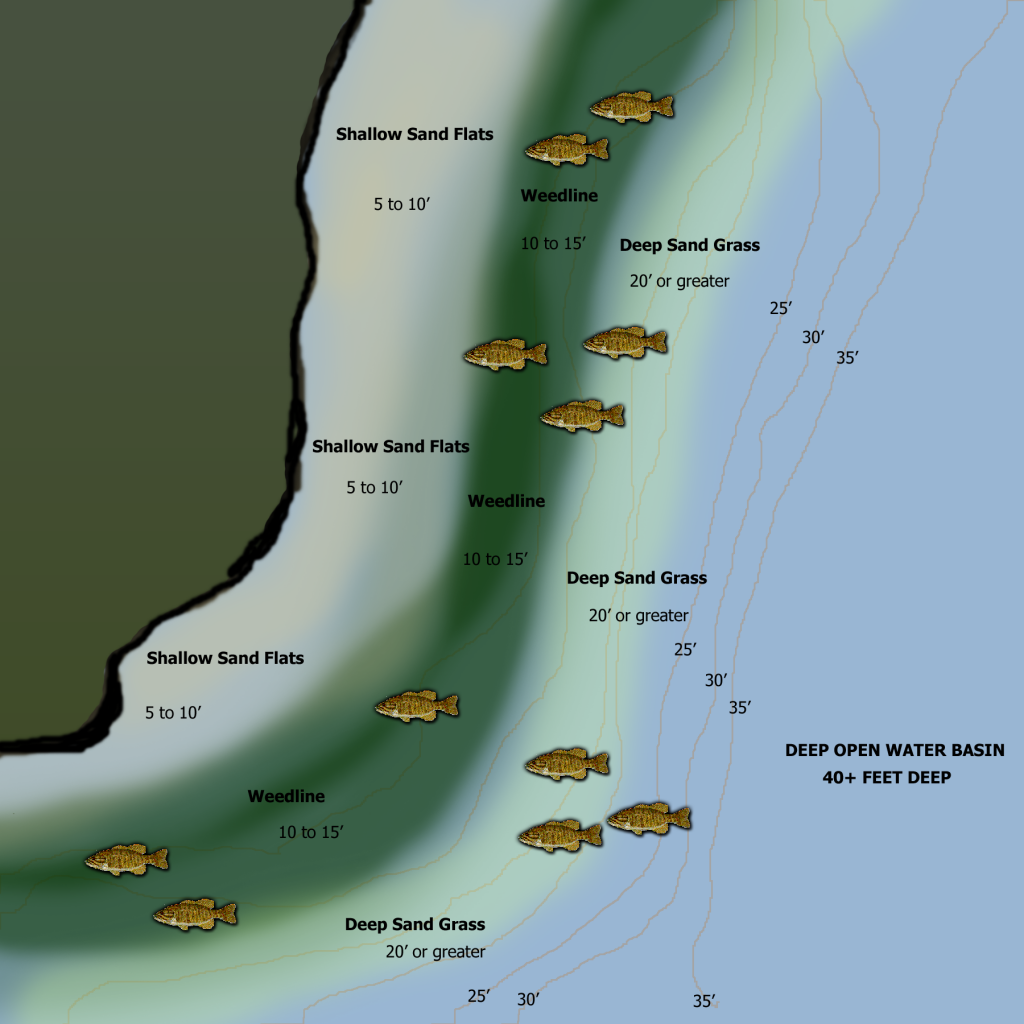 The best weedlines I’ve fished almost always run parallel with shoreline, usually a great distance away from it, along the edge of a large sandy shoreline flat. These parallel weedbeds contain both inner and outer weedlines, with adequate depth being found at both ends. Usually these weed beds of broadleaf cabbage and curly leaf pondweed are situated between the depths of five to 20 feet, along the primary breakline, with the inner weedline leading to a shallow sand flat, and the deep weedline giving way to sand grass and open water.
The best weedlines I’ve fished almost always run parallel with shoreline, usually a great distance away from it, along the edge of a large sandy shoreline flat. These parallel weedbeds contain both inner and outer weedlines, with adequate depth being found at both ends. Usually these weed beds of broadleaf cabbage and curly leaf pondweed are situated between the depths of five to 20 feet, along the primary breakline, with the inner weedline leading to a shallow sand flat, and the deep weedline giving way to sand grass and open water.
Depth and location are critical in the productiveness of the weedline. On these deep clear lakes, transparency is at a premium as some weedlines can run to depths of 25 feet. Most, however, average 8 to 15 feet. The best weedlines are those with a deep inside and outside edge. Weedlines like these, which can be fished from both sides and offer boat positioning from shallow and deep, are always must-fish areas.
The last point that determines whether or not the weedline is conducive to smallmouth fishing is its consistency and thickness. Most smallmouth weedbeds typically feature an inside edge with a noticeable wall of growth, separating the shallow sand and gravel flat from the interior of the bed, and an outside edge of scattered vegetation that eventually progresses to sand grass, a deep drop-off, and open water. The best weedlines for smallmouths will typically offer equal amounts of pockets and openings, a number of inside turns, and scattered clumps that fish may use for cover. Unlike largemouths which bury themselves deep into vegetation, smallmouths will be on the move like a gang of bikers, swimming amongst the openings and scattered clumps to travel and ambush prey.
The majority of the weedlines I fish on some of my largest and deepest smallmouth lakes are avoided by most bass anglers because they are perceived to mainly hold pike and muskies, and few quality bass. They are wrong, as a few of these weedlines I regularly fish produce smallmouths up to five pounds each year.
Weeding out the Smallmouths
There are endless ways to successfully fish a weedline. Given the nature of cruising smallmouth bass, and the need to cover water for active fish, logic says to rip crankbaits, rattlebaits, hollow body swimbaits and jerkbaits through the openings and edges of cabbage. Heck, maybe even a spinnerbait across the top of the bed too. All are viable options, and the likely first choices to try. However, they are all mistakes to avoid thanks to fishing pressure and the wariness of bass in clear water. I epitomize power fishing, especially with a suspending jerkbait such as the Rapala X-Rap as it catches smallmouth bass almost everywhere. But in order to catch smallmouths from weedlines all the time, you must be versatile enough to finesse. In order to do so, and to be wildly successful at it, the jigworm must be fished.
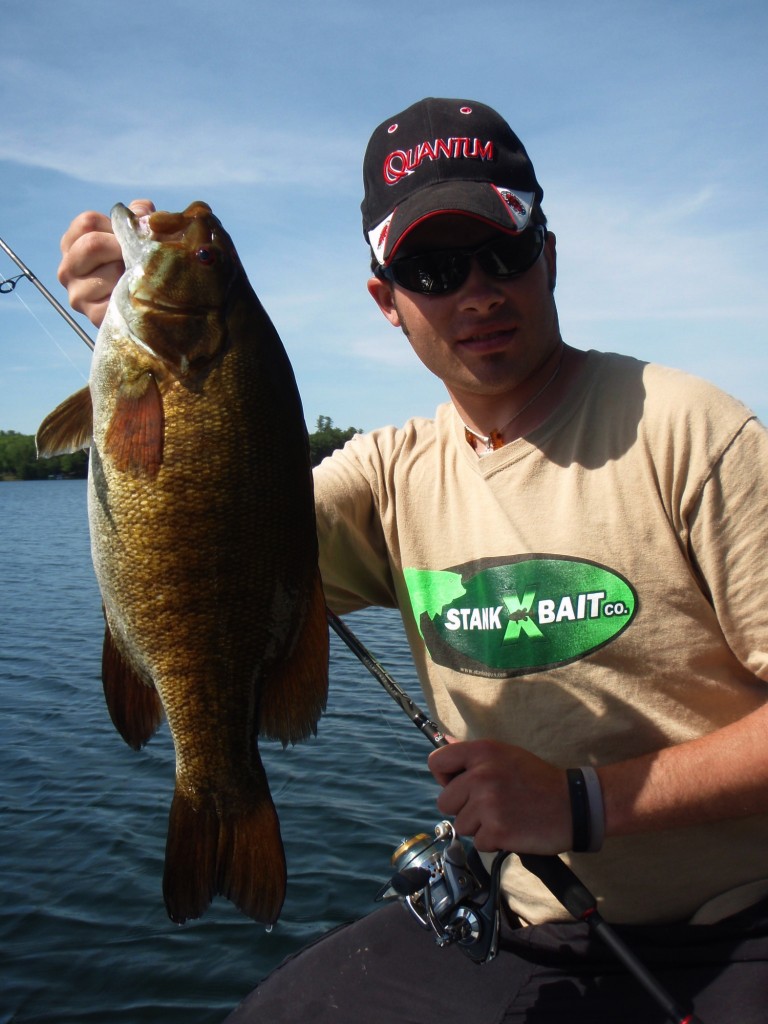
My introduction to jigworms first took place eight years ago as I began exploring the countless number of natural lakes of the Wisconsin northwoods with its bountiful bass populations. Since then, the jigworm has become one of my go-to baits for year round smallmouth bass. Now, it’s a practice that outfishes everything else, including other boats.
In comparison to power fishing, finessing the weedlines with jigworms elicits more strikes than minnow imitators and other plastics because they enable anglers to precisely fish edges and open pockets, and present a naturally looking presentation to fish. They’re exceptionally effective in clear water, when angling pressure is intense, during high pressure systems and windless days, and when bass aren’t actively feeding. They excel in water temperatures between 66-76 degrees, and are effective until the first cool down in early fall.
During the early days of bass fishing, the first jigworms consisted of stand-up jig heads with reaper tails. Over the years, swimming tail worms became the standard. Today, everything from craws, to paddle tail plastics, swimming grubs, and straight sinking worms such as senkos are employed by jig. If it’s plastic and has a tail, there’s a good chance it’s going to be fished with a jig.
The best smallmouth worms are small in the 4 to 6 inch range. Color, texture, thickness and action are all equally critical and have to be matched to every situation. When rigged accurately to all the variables involved, a worm is dangerous on smallmouths and most of the time nothing works better.
Since the early days of jigworm fishing, spinning tackle has been the gear of choice. As a finesse technique, light line in the 6 to 8 pound range improves the appearance and underwater action of small worms and leads to far greater casting distance when coupled with a long, medium fast action rod. When fishing for smallmouth bass on any lake, I always have at least two or three jigworm rods rigged and ready to cover all scenarios. Jigworms are harder to cast than most ordinary plastics, but medium fast action rods in the 7 to 7 ½ foot lengths are ideal. The perfect reel to handle 6 and 8 pound line is moderate in size, such as the Quantum Energy 20 and 30 models. With jigworms, it is important to spool supple monofilament or copolymer lines to maximize on casting distance, and allow for strength for hook-sets and weed absorption. Such lines to use are Cortland Endurance, P-Line Evolution, and P-Line Fluoroclear. With the light line and fast action rods, lost fish and break-offs are an afterthought.
Jigworm Styles
When rigged on jigs, action tail worms, ribbon tails, and swimming grubs in the 4 to 6 inch range look like most minnow species smallmouths want to eat. Each of these plastics offers different swimming characteristics and retrieves when fished with specific jig head styles.
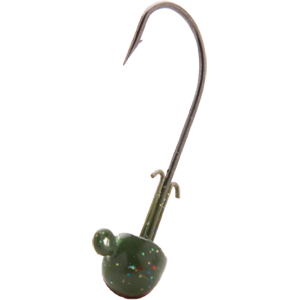 I fish with four particular styles of jigworms. They are ballhead, weedless, mushroom, and swimming. Ballhead is my favorite and most frequently used as light jigs such as the Owner Ultrahead in 1/16 and 1/8 ounce can be fished with most plastics. For combing through weedlines, the ballhead jig is solid for casting distance, and letting it fall into openings. Ballheads excel in dragging worms along the bottom, and letting them hang and drop slowly.
I fish with four particular styles of jigworms. They are ballhead, weedless, mushroom, and swimming. Ballhead is my favorite and most frequently used as light jigs such as the Owner Ultrahead in 1/16 and 1/8 ounce can be fished with most plastics. For combing through weedlines, the ballhead jig is solid for casting distance, and letting it fall into openings. Ballheads excel in dragging worms along the bottom, and letting them hang and drop slowly.
The weedless jig is available in several designs to be fished through vegetation. Owner has a unique design with their Ultrahead Bullet, which is a Texas rigged tapered leadhead featuring a wide gap bend to hold plastics straight and securely. Another similar type is the Charlie Brewer slider head. When swam through weed openings, these jigs provide a horizontal fall and 100% snag resistance.
The mushroom jig is the most popular style for jigworm fishing and is a staple for fishing outside weedlines and ripping through stalks of cabbage and pondweed. Mushroom heads feature a forward line tie that enables them to slide through weed stalks. They are fished best on shortened versions of stickbaits, and swimming grubs that are meant to be fished along bottom.
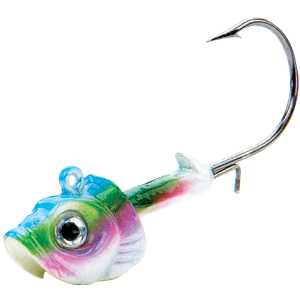 Finally, the last jigworm I frequently fish with is the swimming jig. Like its cousin the darterhead, the swimming jig has become popular in recent years due to its more streamlined swimming capabilities, resistance to vegetation, and abilities to catch suspended bass. The swimming jig has a triangular shaped head style with a 90 degree eye that extends above the top of the jig. Like the ballhead and mushroom jig, the swimming jig is an open-hook jig that fishes best with sickle tail worms, ribbontail worms, and swimming grubs. Companies such as Matzuo and Northland offer realistic head versions of the swimming jig as they feature detailed color patterns and 3D eyes to resemble preyfish.
Finally, the last jigworm I frequently fish with is the swimming jig. Like its cousin the darterhead, the swimming jig has become popular in recent years due to its more streamlined swimming capabilities, resistance to vegetation, and abilities to catch suspended bass. The swimming jig has a triangular shaped head style with a 90 degree eye that extends above the top of the jig. Like the ballhead and mushroom jig, the swimming jig is an open-hook jig that fishes best with sickle tail worms, ribbontail worms, and swimming grubs. Companies such as Matzuo and Northland offer realistic head versions of the swimming jig as they feature detailed color patterns and 3D eyes to resemble preyfish.
The typical jigworm presentation on clear smallmouth lakes requires little physical effort and depthfinder skills. However, it does involve a lot of sight fishing in order to observe weedlines and their openings, and to make long accurate casts to the targets. The standard weedline technique is to cast the jig and let it fall on a slack line. Some hits may come immediately on the fall, or as it hops and swims back to you. When smallmouths are relating to the bottom, let the jigworm sit for 5 to 10 second intervals between the retrieve. Most fish will usually end up watching the jigworm from a distance, then approach close, and engulf it. On some days when wind is present, bites may go undetected. Always be prepared to set the hook. At this point of the season, suspending becomes a habit for bass. For fish that are cruising and suspending, and trailing schools of baitfish, swimming a jigworm such as a swimming jig with 4 inch grub is hard to beat.
However you rig it, a jigworm fished amongst weedlines is irresistible to smallmouth bass. Despite its simplicities and unchanged qualities, it continues to be popular for finesse fishermen. Most traditional bass anglers wouldn’t dare use spinning gear and light line to extract fish from any vegetation. But besides spooking fish with baitcasters and power lures, what do they know? Hopefully they come to realize that jigworms are an underutilized tactic for the underfished weedline smallmouth bass.





